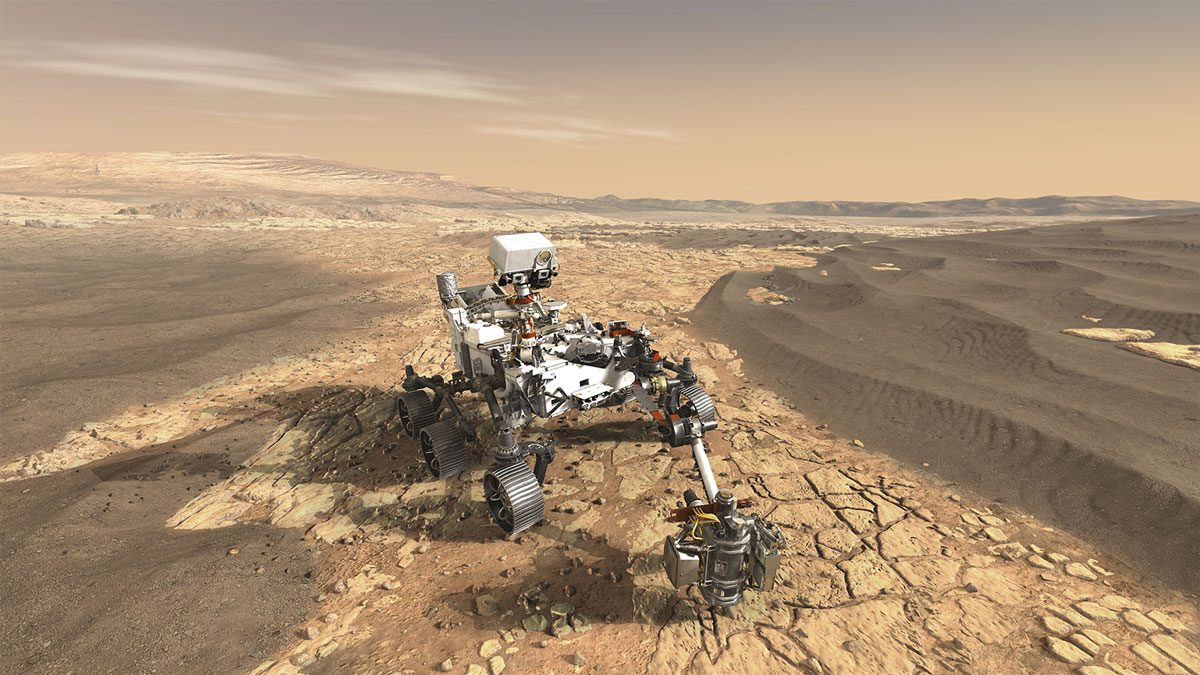Objectives

Missions before Perseverance have found that liquid water existed on Mars in the ancient past and they explored the planet’s “habitability.” For example, at its landing site in Gale crater, the Curiosity rover found the chemical building blocks of life and energy sources that microbes could have used, and established that Mars indeed had regions that could have been friendly to life in the ancient past.
Perseverance will take the next natural step in Mars exploration. It will look for places in Jezero Crater that were habitable in the distant past, ask whether life ever existed there, and look for signs of ancient life. Perseverance will also study the evolution of Mars’ climate, surface, and the interior of the planet. The rover will test out technologies for future human exploration of Mars. In addition to these science goals, Perseverance has a unique goal of collecting and caching samples of Mars material for possible future return.
Since other missions before it did not collect and cache samples, they were focused solely on studying the surface to answer science questions. For Perseverance, on the other hand, the goal of collecting and caching samples changes the team’s approach to science exploration. The scientific exploration and analysis that the team carries out supports the unique goal of caching samples that best represent Mars as a planet.
Perseverance has four science objectives:




Objective A: Geology
Study the rocks and landscape at the landing site to reveal the region’s history.
Characterize the processes that formed and modified the geologic record within a field exploration area on Mars selected for evidence of an astrobiologically-relevant ancient environment and geologic diversity.
One of the goals of the Mars 2020 mission is to explore an area that once had the potential to host and preserve ancient life. Perseverance will explore a region that could answer key questions about the potential for ancient life on Mars: Was it warm? Was it wet? Was it hospitable to life?
This is why Jezero Crater was selected as Perseverance’s landing site. From orbit, scientists see that the crater was home to an ancient delta, flooded with water. Clay minerals and carbonates, which form only in the presence of water are visible there from orbit. Carbonates are also a great material that “records” ancient climate. On Earth, carbonates are commonly produced by life, and are known to preserve evidence of it. This makes Jezero Crater a promising place in which to search for signs of ancient life.
To meet its first objective, Perseverance will:
- Study the area to understand its historical climate and environment.
- Study its geologic diversity to determine the different types of rocks and minerals present.
This is important because carbonates and certain types of clays can be great minerals in which to look for signs of past life, whereas volcanic rocks are good candidates to determine the age of the location the rocks were obtained from.
This information will help piece together a larger picture of what Jezero Crater was like in the ancient past. It will help tell us what the climate was like there, whether the delta and lake settings were friendly to life, and for how long.
Objective B: Astrobiology
Determine whether an area of interest was suitable for life, and look for signs of ancient life itself.
Perform the following astrobiologically-relevant investigations on the geologic materials at Jezero Crater:
- Determine the habitability of an ancient environment.
- For ancient environments interpreted to have been habitable, search for materials with high biosignature preservation potential.
- Search for potential evidence of past life using the observations regarding habitability and preservation as a guide.
Once Perseverance has a chance to study the landing site and its history, the team should be able to identify whether any locations in the crater were habitable (were liquid water and the chemical building blocks of life present there in the past).
As the rover explores Jezero Crater, it will look for areas that were particularly friendly to life, and there, the team will look for deposits that could have preserved signs of ancient microbial life. For example, clays and carbonates form only in the presence of water, and certain types of clays can preserve signs of past life as can carbonates. On Earth, carbonates are commonly produced by life and are known to preserve evidence of it. If they find such materials, the team can use the rover’s instruments to search for potential signs of past life. These signs could include characteristic shapes in rocks, or “patterns” in rock chemistry.
We do not yet know whether Perseverance will find this evidence of past life, but if it exists, the rover has the right tools to look for it.
Objective C: Sample Caching
Cache samples for possible future return to Earth.
- Obtain the most promising samples that represent the geologic diversity of the landing site, and document the context of those samples thoroughly.
- Ensure compliance with future needs in the areas of planetary protection and engineering so that the cached samples could be returned in the future if NASA chooses to do so.
Perseverance has 38 empty tubes in which it can store samples of Mars rock and soil. By the end of its mission, it will collect approximately 30 samples.
Documenting Context in the Field
Scientists working on Earth normally collect samples in person. While collecting a sample, it is very important to document the surrounding “context” of any samples, or the environment and surroundings in which it occurs. This way, when the samples are brought to the lab, anyone working with them can find out more about where the samples were collected and why.
The set of samples Perseverance collects would be the first ever Mars samples brought back to Earth. Since Perseverance does not have a human travelling with it as it collects samples, teams back on Earth must document the context in which each sample is collected in detail. This includes information such as where the sample was taken, which types of rock were found above or below it, why it was collected, and any other information that would help science teams.
The Sample Set must be Geologically Diverse
If and when these samples are brought back, they will represent the planet Mars, and thus, should present as complete a picture of the landing site as possible. Different types of samples will help shed light on different aspects of the history of the crater; this is why the mission team must ensure that they contain a variety of rock and soil types from within Jezero Crater.
For example, we know based on observations from orbit that carbonates and clays are present in Jezero Crater. Carbonates and certain types of clays are good candidates in which to look for signatures of past life as they form in the presence of water. Carbonates are also a great material that “records” ancient climate. On Earth, they are commonly produced by life, and are known to preserve evidence of it. Clays and sediment brought in by the river were possibly deposited and buried in the ancient river delta within Jezero Crater. These clays can preserve “biosignatures,” or signs of past life. On the other hand, the floor of Jezero Crater may contain volcanic rocks. Samples of volcanic rocks would be ideal for determining the age of a location where they were obtained. Still other samples may shed light on the ancient climate of the Red Planet. This is why the Perseverance team will set out to collect a diverse set of samples at Jezero Crater.
Designing the Tubes for Safe Return
The rover may deposit the samples at one or more suitable locations on the surface of Mars. The tubes with the samples were designed so that they can be brought back to Earth safely someday.
If and when the sample tubes are brought back, teams on Earth would have all the background information they need to understand where, how, and when the sample was acquired. They could possibly make connections between the types of samples collected, and find out more about the environment in which they transformed, adding deeply to our understanding of the history of Mars as a planet.
Objective D: Prepare for Humans
Test technologies that would help sustain human presence on Mars someday.
Contribute to the preparation for human exploration of Mars by making significant progress towards filling at least one major Strategic Knowledge Gaps. The highest priority measurements that are synergistic with Mars 2020 science objectives are:
- Demonstration of In-Situ Resource Utilization technologies to enable propellant and consumable oxygen production from the Martian atmosphere for future exploration missions.
- Characterization of atmospheric dust size and morphology to understand its effects on the operation of surface systems and human health.
- Surface weather measurements to validate global atmospheric models.
- A set of engineering sensors embedded in the Mars 2020 heat shield and backshell to gather data on the aerothermal conditions, thermal protection system, and aerodynamic performance characteristics of the Mars 2020 entry vehicle during its entry and descent to the Mars surface.
Perseverance will test technologies that would help sustain human presence on Mars someday.
Its Mars Oxygen In-Situ Resource Utilization Experiment or MOXIE instrument will demonstrate a way that future explorers might produce oxygen from the Martian atmosphere for propellant and for breathing.
A weather station on the rover known as the Mars Environmental Dynamics Analyzer, or MEDA, will help study the shape and size of the dust in the atmosphere. This knowledge will help shed light on how Mars dust may affect human health. The instrument’s measurements include wind speed and direction, temperature and humidity, as well as the amount and size of dust particles in the Martian atmosphere.
Measurements of the weather collected on the surface will add to an understanding of the Martian atmosphere as a whole.
To further our understanding of the temperature conditions in the Mars atmosphere, the mission will also collect information during its entry, descent, and landing phase using MEDA. This suite of sensors is attached to the heat shield and backshell and collects data as the spacecraft plunges through the atmosphere.
One of its instruments, the Scanning Habitable Environments with Raman & Luminescence for Organics & Chemicals, or SHERLOC also carries small pieces of spacesuit material. It targets them to test its accuracy and to see how they hold up in the harsh Martian environment.

